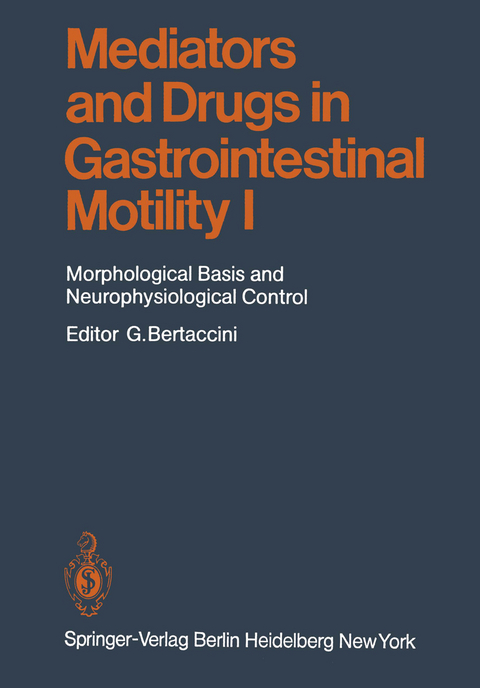
Mediators and Drugs in Gastrointestinal Motility I
Springer Berlin (Verlag)
978-3-642-68439-5 (ISBN)
Since the exhaustive Handbook of Physiology (Alimentary Canal, Section 6, Motility) edited by CHARLES F. CODE in 1968, no complete survey of the morphological basis and the physiological control of intestinal motility has been published, in spite of the enormous amount of new data in the literature on this topic. The new techniques and methodologies, the use of electron microscopy, radioimmunoassay and binding techniques, as weIl as ever more sophisticated electrophysiological procedures have made possible areal flood of discoveries in this field. Moreover, the possibility ofnew studies ofthe endocrine cells in biopsies of human intestinal mucosa even during routine endoscopies, has opened new horizons for gastroenterologists and generated a number of important contribu tions to our knowledge of the morphology and physiopathology of the gut. As usual, new discoveries have also revealed both ignorance and many new problems. For tbis reason, although many of the data reported in this volume can be considered as firmly established, others still require confirmation, and the results of new research in this field are awaited with extreme interest. Since advances are occurring so rapidly, even experts in the specific topics need frequent comprehensive reviews. To avoid an excessively large volume, considera tions ofthe pancreas, liver, and biliary system were not included in this Handbook, which, nevertheless, has attempted to off er the reader the essence of more than 1,500 papers.
1 Historical Perspective.- 2 Morphological Basis of Gastrointestinal Motility: Structure and Innervation of Gastrointestinal Tract.- A. Introduction.- B. Structure of Smooth Muscle.- C. Innervation of Gastrointestinal Smooth Muscle.- D. Integration of Extrinsic and Intrinsic Neurons into Reflex Circuits.- E. Conclusions.- References.- 3 Morphological Basis of Gastrointestinal Motility: Ultrastructure and Histochemistry of Endocrine-Paracrine Cells in the Gut.- A. General Cytology and Physiology.- B. Classification and Description of Cell Types.- C. Pathology.- D. Summary.- References.- 4 Ionic Basis of Smooth Muscle Action Potentials.- A. Introduction.- B. Methodologic Problems.- C. Effects of Na Ions.- D. Effects of Tetrodotoxin.- E. Na-Dependent Activity in Ca-Free Solution.- F. Effects of Ca Ions.- G. Regulation of Intracellular Ca.- H. Effects of Intracellular Ca.- I. Effects of Decreasing K Conductance.- K. Effects of Membrane Polarization.- L. Effects of Ca Antagonists.- M. General Properties of Spikes and Their Implications.- N. Summary.- References.- 5 Electrophysiology of Intestinal Smooth Muscle.- A. Introduction.- B. Methods Used In Electrical Recording.- C. Electrical Activity of Gastrointestinal Smooth Muscle.- D. Relationship Between Electrical and Mechanical Activity.- E. Migrating Myoelectric Complex.- F. Electromyography in Clinical Practice.- References.- 6 Electrophysiology of the Enteric Neurons.- A. Introduction.- B. Extracellular Recording Techniques.- C. Intracellular Recording Techniques.- D. Actions of Endogenous and Exogenous Substances on Enteric Neurons.- E. Functional Roles of Enteric Neurons in the Control of Gastrointestinal Motility.- References.- 7 In Vivo Techniques for the Study of Gastrointestinal Motility.- A. Introduction.- B. Techniques for the Study of Wall Movements.- C. Techniques for the Study of Intraluminal Pressure.- D. Techniqes for the Study of Transit of Contents.- E. Use of Combined Techniques.- References.- 8 In Vitro Techniques for the Study of Gastrointestinal Motility.- A. Introduction.- B. General Methodology.- C. Muscle Segments and Strips.- D. Gastric Motility.- E. Intestinal Peristalsis.- F. Effects of Stretch on Muscle Strips.- G. Electrical Stimulation of Autonomic Nerves.- H. Conclusions.- References.- 9 Nervous Control of Esophageal and Gastric Motility.- A. Nervous Control of the Esophagus.- B. Nervous Control of the Stomach.- References.- 10 Nervous Control of Intestinal Motility.- A. Introduction.- B. Neuromuscular Transmission in the Intestine.- C. Transmission and Pathways in Enteric Ganglia.- D. Initiation of Sensory Inputs in the Intestine.- E. Electrical Stimulation of Extrinsic Nerves.- F. Conclusions on Neuromuscular and Ganglionic Transmission in the Intestine.- G. Patterns of Motility of the Intestine.- H. Nervous Control of Intestinal Motility.- J. Role of Intrinsic Nerves in the Pattern of Intestinal Motility in the Freely Fed State.- K. Extrinsic Intestinal (Intestinointestinal) Reflexes.- L. General Summary and Conclusions.- References.- Note Added in Proof.- 11 Identification of Gastrointestinal Neurotransmitters.- A. Criteria for Transmitter Identification and Their Application to the Intestine.- B. Evidence that a Number of Different Neurotransmitters are Released in the Gastrointestinal Tract.- C. Identification of Acetylcholine as an Intestinal Transmitter.- D. Noradrenaline as an Intestinal Transmitter.- E. Evidence For and Against 5-Hydroxytryptamine.- F. Evidence For and Against Dopamine.- G. Evidence that ?-Aminobutyric Acid is a Neurotransmitterin the Intestine.- H. Identification of the Transmitter Released from Enteric Inhibitory Nerves.- J. Peptides as Intestinal Transmitters.- K. Summary.- Note Added in Proof.- References.
| Erscheint lt. Verlag | 23.11.2011 |
|---|---|
| Reihe/Serie | Handbook of Experimental Pharmacology |
| Co-Autor | H.G. Baumgarten |
| Zusatzinfo | XX, 470 p. |
| Verlagsort | Berlin |
| Sprache | englisch |
| Maße | 170 x 244 mm |
| Gewicht | 846 g |
| Themenwelt | Medizin / Pharmazie ► Medizinische Fachgebiete ► Pharmakologie / Pharmakotherapie |
| Medizin / Pharmazie ► Pharmazie ► PTA / PKA | |
| Naturwissenschaften ► Biologie ► Humanbiologie | |
| Schlagworte | Acetylcholin • adenosine • Catecholamines • Chemistry • dopamine • Drugs • Endoscopy • Glucagon • Motility • Muscle • neurons • Neurotransmitter • pharmacology • Physiology • Research |
| ISBN-10 | 3-642-68439-4 / 3642684394 |
| ISBN-13 | 978-3-642-68439-5 / 9783642684395 |
| Zustand | Neuware |
| Haben Sie eine Frage zum Produkt? |
aus dem Bereich


